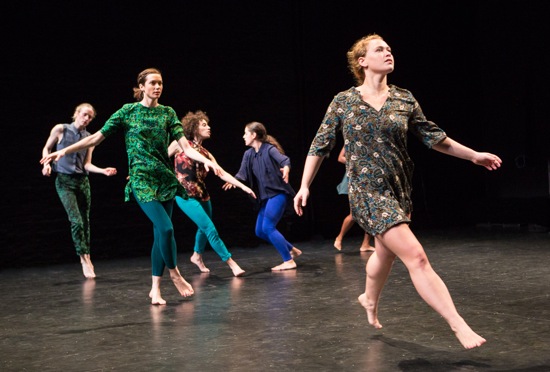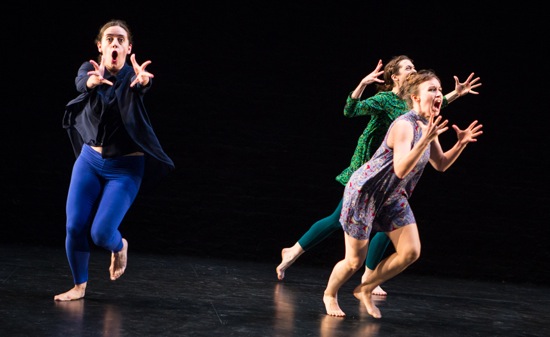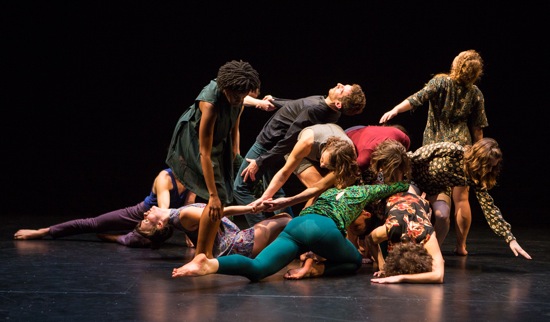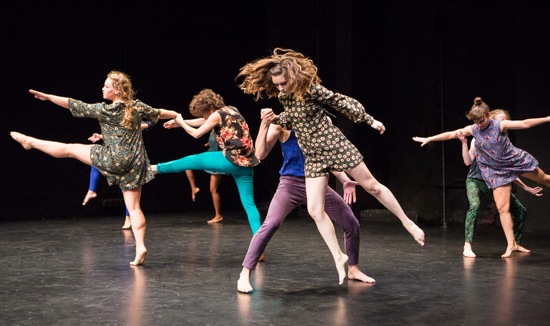Tere O’Connor’s The Goodbye Studies creates a world of hidden depths at The Kitchen.

Tere O’Connors’ The Goodbye Studies. (L to R): Oisin Monaghan, Mary Read, Lily Gold, Tess Dworman, and Laurel Snyder. Photo: Yi-Chun Wu
City dwellers know what it’s like to be part of a crowd. In Grand Central Station at rush hour, people speed along—dodging one another and laying down complex swerving paths. In a breadline or trying to push their way en masse through a single entrance or exit, they move toward their goal in small steps. Gathered to watch a building in flames, diverse as they are, they share a common focus.
In a program note about Tere O’Connor’s new The Goodbye Studies, the choreographer writes that “This dance considers the crowd as protagonist where everyone replaces someone as subject. Images of masses of people trudging through their misfortunes or fighting for empowerment are ubiquitous and are a background presence in this dance.” He is not talking about a Swan Lake situation here.
O’Connor does not tell stories. Working with twelve dancers—almost all of them also choreographers and many of them artists in other fields—he embeds them in a structure that reveals (or conceals) itself in fragments and interpenetrating layers. And one of the things he likes about dance is that it resists being pinned down—embracing as it does the multiplicity of meanings that human movement can convey. (A woman buries her face in her hands. Is she weeping? Is she resting her eyes? Is there something she’d rather not look at? Is she experimenting with a gesture that a choreographer has provided?)

(L to R): Tess Dworman, Mary Read, and Natalie Green in The Goodbye Studies. Photo: Yi-Chun Wu
Watch an ant community at work over a period of time, and you learn the busy workers’ goals. But although the dark gray box of The Kitchen fills and empties with activity over the course of The Goodbye Studies and you watch it fascinated, you do not try to discern its purpose(s). The dance reveals its life through surges, pauses, scattered activities, sudden decisions, and entanglements.
There’s an irony at work here, and O’Connor is aware of it. A crowd, a workplace—even at times a mob—is made up of individuals acting together or at odds. He accentuates this by by introducing these marvelous, very diverse dancers singly, in pairs, or threes and letting us see them as thinking individuals. We get a good long look at Lauren Vermilion, for instance; she begins the piece by walking alone into the empty space, surveying it, and walking out again. She re-enters. Mary Read joins her in walking around. Then Angie Pittman and Natalie Green. Michael Ingle, Joey Loto, Simon Courchel enter, not quite simultaneously, from different directions. Oisin Monaghan. Lily Gold. Tess Dworman. Laurel Snyder limps for a few seconds. Ingle drags a foot, but otherwise, they just trace their paths.
Then they stop, all facing the same way, spangling the space. Count them: eleven (Eleanor Hullihan is injured). Now (very interesting) they slide their eyes to the left or the right, then suddenly cringe in different ways, drop to the floor, shake, get up and compose themselves, and. . . .CRASH!! James Baker’s score makes a very loud entrance, and Michael O’Connor’s lighting supports it with brightness.

Tere O’Connor’s The Goodbye Studies. L to R: Angie Pittman, Simon Courchel, Laurel Snyder (standing); Michael Ingle, Eleanor Hullihan, Lauren Vermilion (bent over); Joey Loto, Natalie Green, Mary Read, Lily Gold (on floor). Photo: Yi-Chun Wu
O’Connor shows this organism, this structure, in energetic activity, marked by pauses for repose or stares in our direction. It clusters and compresses in the space, breaks open, reconfigures. Its components, aka dancers, swirl and dart around within the complex whole .Individuals ignite new behavior; they also assist one another in various ways—pushing, pulling, lifting, grasping hands to form a sculptural vision. They spin apart and reconnect. Their faces suddenly and briefly assume expressions we associate with horror or pleasure; they smile in apparently sincere ways for no discernible reason. In temporary pairs, people whisper in their partner’s ear. There are hints of violence, performed without animosity. In one sequence, Dworman is repeatedly pushed in the chest; then the crowd finds another person to push. And another.
Baker’s score is full of contrasts. Near the end, kids’ singing voices dredge up hallelujahs, but one of the most prominent repeated aural images is of many boxes tumbling loudly down flights of stairs. Thudding noises occur, so do drum beats, so does metallic clanging. At times, a tone seems to act as a signal for a move or a change.

The Goodbye Studies. (L to R): Laurel Snyer and Lily Gold, Lauren Vermilion and Joey Loto, Natalie Green and Oisin Monaghan. Hidden at back: Tess Dworman and Michael Ingle. Photo: Yi-Chun Wu
Unison dancing—cleanly defined or with a slight raggedness that permits personal deviations— is redefined as the parts of this social organism functioning in synchrony. Deciding on a common practice seems to happen as part of a natural process. Maybe it involves several people walking on tiptoe or sitting and thrashing violently or stirring the air with fluid, curving gestures. And although much of what they do is pedestrian, they also, in various ways, prance, jump, leap, swing their legs around, i.e. dance.
The Goodbye Studies is still vivid in my mind. Masterfully created, organized, and performed, it brings to artistic life the structures that are powerful, threatened, considerate, or potentially dangerous in the world today. Factions society stir up divisiveness, schisms to do with ethnicity, religion, and culture erupt. I don’t know what O’Connor means by his title, but there are a lot of goodbyes currently rampant in society. Goodbye to civility, equality, compassion, ethical behavior. Let’s hope it’s not farewell.
